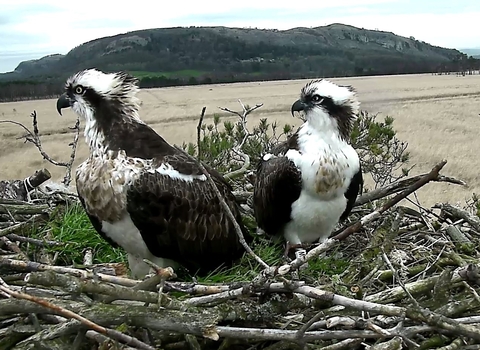Chick number one hatched at teatime on Friday 24 May and chick number two emerged at lunch time on Sunday 26 May. Both chicks hatched 39 days after their eggs were laid. They were a couple of days later than last year – perhaps they were waiting for better weather!
A cracking weekend for the #FoulshawOspreys
© Cumbria Wildlife Trust
Over the weekend we had two new arrivals as our first two osprey chicks hatched. Another is due to emerge in a day or so – fingers crossed!
First egg hatches and first feed 24.5.24 (https://youtu.be/xwp_kyAVnvw )
© Cumbria Wildlife Trust
The first chick of 2024 emerges from its egg.
Chick number two emerges and feeds 26.5.24 (https://youtu.be/czr538f-ZUs)
© Cumbria Wildlife Trust
Chick number two emerges two days later.
The parents, White YW and Blue 35, have been carefully incubating the eggs over the past few weeks, protecting the nest from intruders, preparing a deep egg cup, and building up the sides of the nest with twigs and sticks.
Both parent birds have incubated the eggs with the male, White YW, doing his fair share. He seems to have done all of the fishing, bringing food back to the nest for the female. She's had her time off the nest to feed, to freshen up or get a comfort break.
Intruder
We've had a persistent intruder who seems to have their eye on the nest. Most of the time, White YW has been around to help chase him off, but Blue 35 has had to fend for herself – very successfully – when she's been alone.
Intruder pestering Blue 35 2024 (https://youtu.be/eztz-xqEKC8)
© Cumbria Wildlife Trust
Eagle-eyed osprey cam viewers have managed to identify the intruder as Blue 478. This is a male that hatched in 2021 from a local nest. He's just about old enough to breed and is looking for a favourable site and mate. I’m sure we’ll see him back again.
Night visitor (https://youtu.be/GYZyTvQ_v4c)
© Cumbria Wildlife Trust
Night Visitor
There 's not much to disturb the nest at night. This spider must have made a considerable effort to climb to the top of this tall tree! I’m sure it would have been worthwhile for the feast of flies that buzz around the nest.
Spot the difference
Can you tell the difference between Blue 35 and White YW when they're are on the nest? It’s ok when you can see their coloured Darvic rings, but when they're sitting tight on the nest, it’s not so easy.
Female ospreys are generally about 20% bigger than male ospreys. They have eggs to develop and incubate and young to feed. The males are smaller and more streamlined, which probably helps them when they're fishing.
You can see from the photos that Blue 35 is larger and her feathers look more ruffled from all the incubating she's been doing. Her breast feathers are also much browner than White YW’s.
There may be other markings and characteristics that you've noticed while watching the cam. She does seem to have a tendency to throw more nest material onto her back while she’s incubating. Why does she do it? Is she bored, or hot or cold? Does she do it to dry her feathers or to camouflage herself? It’s a mystery!
Blue 35 nesting 2024 (https://youtu.be/OCSlHHB53yM)
© Cumbria Wildlife Trust
Do keep an eye on the nest at Foulshaw Moss nature reserve via our live osprey cam. A huge thanks to the osprey cam spotters who've noted the significant moments in the lives of our #FoulshawOspreys so far.
This blog was written by one of our volunteers, Jenny Cornell. If you'd like to volunteer with the Trust to help Cumbria's wildlife & wild places too, then we'd love to here from you - click here to find out how to volunteer with us.

Osprey nest
Watch the osprey family, in their nest and roost tree, at Foulshaw Moss Nature Reserve. They're usually here between March to early September.




